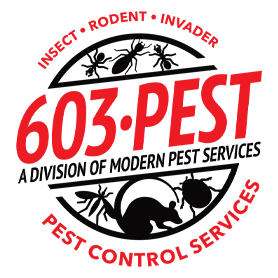Call Today: 603-210-2773
Or Request More Info.
"*" indicates required fields
Termite Treatment & Inspection
Termite Protection Overview
Termites are destructive pests that require expert termite control. New Hampshire property owners rely on 603 Pest Control as their local professional termite exterminator.
Our comprehensive termite treatment is a systematic process and strategy – from termite inspection to termite removal – that protects property and provides peace of mind for commercial and residential clients.
Termite Treatment Solutions
The only type of termites in New England are subterranean termites that live in soil, so we target our termite treatment on the soil.
603 Pest Control offers two types of termite treatment:
- Advanced Bating Termite Treatment is our most popular method of termite control. It is performed from the exterior of structures, and is less intrusive than a liquid treatment because it does not require drilling through concrete. Termites come up, feed on the advanced bate, and bring it back to the colony.
- Liquid Termite Treatment involves drilling into the concrete every 12 inches, from outside of the foundation, and pumping a material underneath the concrete slab to reach the soil where the termites live. We also create a small trench and treat the trench, to provide a barrier around the home. Termites will come up through the material, pick it up on their bodies, and carry it back to the colony.
How to Identify Termite Activity Around Your Home or Property
Workers or worker termites are the lighter-color, maggot-like termites that cause property damage.
Soldiers or soldier termites are white with large heads and mandibles.
Swarmers or swarmer termites are commonly confused with carpenter ants because they have wings. But swarmers are flat, and do not have a pinched waist like carpenter ants do.
Termite swarm occurs during a 6-8 week period in the spring, and termites remain active from April through September in NH. It is typical to only see termites when they are swarming
During termite swarm, the reproductive (winged) termites mate in the air and fall back to the soil to lay their eggs. These eggs must stay in constant contact with the soil to stay moist.
The first termites people notice are these winged termites. But even if they never see any type of termite, they will definitely see the destruction that the worker termites cause by eating the wooden parts of their home, building and other property from the inside out.
Worker termites build and travel through noticeable mud tubes to get to any wooden parts of structures such as homes, buildings, and decks. These mud tubes can be seen along concrete walls inside or outside of basements and foundations, and extending from the floor to the wood sill plate and up the walls.
Once termites get into the wood, they cause major destruction. They do this by consuming wood, and converting the wood they ingest into cellulose, which they carry back to feed members of the colony.
Disease and Property Damage Termites Can Cause
Termites do not carry or transmit disease. However, they cause major structural damage to residential and commercial properties when left undetected and untreated by a termite removal professional.
Termite Biology
Termites convert cellulose (wood) into substances they can digest, meaning they search for wood as a food source. Of the three species in the U.S., the subterranean termite in the northeast forms colonies in the ground. Colonies consist of a cast system where soldier, worker, nymph and swarmer (winged termites with the ability to reproduce) have specific jobs that benefit the queen and the colony. The worker termites are responsible for providing food to the queen and soldiers, thus, they cause the damage to wooden structures.

